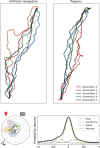Cumulative route improvements spontaneously emerge in artificial navigators even in the absence of sophisticated communication or thought
- PMID: 38843108
- PMCID: PMC11156315
- DOI: 10.1371/journal.pbio.3002644
Cumulative route improvements spontaneously emerge in artificial navigators even in the absence of sophisticated communication or thought
Abstract
Homing pigeons (Columba livia) navigate by solar and magnetic compass, and fly home in idiosyncratic but stable routes when repeatedly released from the same location. However, when experienced pigeons fly alongside naive counterparts, their path is altered. Over several generations of turnover (pairs in which the most experienced individual is replaced with a naive one), pigeons show cumulative improvements in efficiency. Here, I show that such cumulative route improvements can occur in a much simpler system by using agent-based simulation. Artificial agents are in silico entities that navigate with a minimal cognitive architecture of goal-direction (they know roughly where the goal is), social proximity (they seek proximity to others and align headings), route memory (they recall landmarks with increasing precision), and continuity (they avoid erratic turns). Agents' behaviour qualitatively matched that of pigeons, and quantitatively fitted to pigeon data. My results indicate that naive agents benefitted from being paired with experienced agents by following their previously established route. Importantly, experienced agents also benefitted from being paired with naive agents due to regression to the goal: naive agents were more likely to err towards the goal from the perspective of experienced agents' memorised paths. This subtly biased pairs in the goal direction, resulting in intergenerational improvements of route efficiency. No cumulative improvements were evident in control studies in which agents' goal-direction, social proximity, or memory were lesioned. These 3 factors are thus necessary and sufficient for cumulative route improvements to emerge, even in the absence of sophisticated communication or thought.
Copyright: © 2024 Edwin S. Dalmaijer. This is an open access article distributed under the terms of the Creative Commons Attribution License, which permits unrestricted use, distribution, and reproduction in any medium, provided the original author and source are credited.
Conflict of interest statement
The authors have declared that no competing interests exist.
Figures




Similar articles
-
Accurate route demonstration by experienced homing pigeons does not improve subsequent homing performance in naive conspecifics.Proc Biol Sci. 2000 Nov 22;267(1459):2301-6. doi: 10.1098/rspb.2000.1283. Proc Biol Sci. 2000. PMID: 11413647 Free PMC article.
-
Group decisions and individual differences: route fidelity predicts flight leadership in homing pigeons (Columba livia).Biol Lett. 2011 Feb 23;7(1):63-6. doi: 10.1098/rsbl.2010.0627. Epub 2010 Sep 1. Biol Lett. 2011. PMID: 20810431 Free PMC article.
-
Deconstructing the flight paths of hippocampal-lesioned homing pigeons as they navigate near home offers insight into spatial perception and memory without a hippocampus.Behav Brain Res. 2023 Jan 5;436:114073. doi: 10.1016/j.bbr.2022.114073. Epub 2022 Aug 27. Behav Brain Res. 2023. PMID: 36041573
-
Route following and the pigeon's familiar area map.J Exp Biol. 2014 Jan 15;217(Pt 2):169-79. doi: 10.1242/jeb.092908. J Exp Biol. 2014. PMID: 24431141 Review.
-
Cues indicating location in pigeon navigation.J Comp Physiol A Neuroethol Sens Neural Behav Physiol. 2015 Oct;201(10):961-7. doi: 10.1007/s00359-015-1027-2. Epub 2015 Jul 7. J Comp Physiol A Neuroethol Sens Neural Behav Physiol. 2015. PMID: 26149606 Review.
References
-
- Boyd R, Richerson PJ. Why culture is common but cultural evolution is rare. Proc Br Acad. 1996;88:77–93.
-
- Tomasello M. The cultural origins of human cognition. Cambridge, MA, USA: Harvard University Press; 1999.
-
- Tomasello M, Kruger AC, Ratner HH. Cultural learning. Behav Brain Sci. 1993. Sep;16(3):495–511.
MeSH terms
LinkOut - more resources
Full Text Sources

